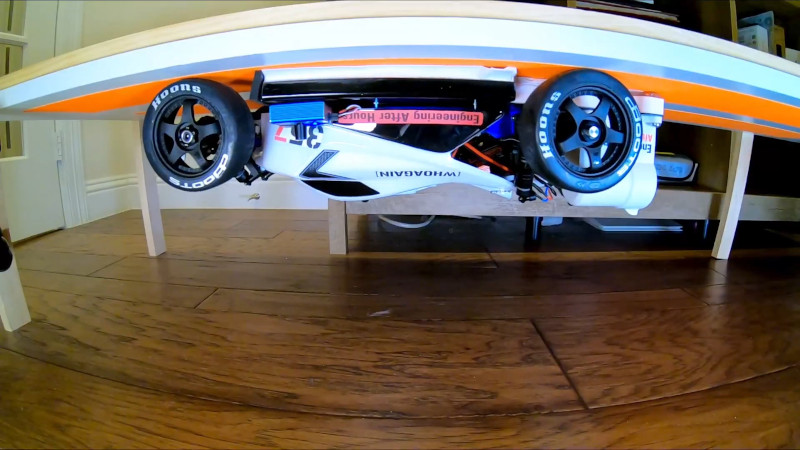We’ve all seen those tiny little RC cars that can climb walls thanks to the suction generated with fans. Their principle is essentially the opposite to that of a hovercraft. [Engineering After Hours] wanted to build his own RC car that could do the same, driving upside down and generating huge amounts of grip.
The build is based on a Traxxas RC car, but heavily modified for the task. An undertray is crafted, with ducts feeding a pair of twin 50mm electric fans. A skirt is fitted around the edge of the undertray, helping create a seal to maximise the downforce generated. This skirt is the area of much engineering effort, as it must form a good seal with the ground, particularly over minor pertubations, without creating undue levels of friction. Suspension components correspondingly need to be beefed up to stop the car bottoming out with the huge downforce generated by the fan system.
After much experimentation, the kinks are worked out, and the car is able to drive upside down successfully. It generates far more downforce than earlier wing experiments from [Engineering After Hours], as expected – with a tradeoff of higher weight and complexity. With the plan to create an RC car capable of huge lateral acceleration, we can’t wait to see what comes next. Video after the break.















SInce everyone is going to say it let me be the first, this SUCKS! :)
Has anyone tried gecko-inspired methods of driving on surfaces?
https://www.researchgate.net/publication/315980548_Controllable_Anisotropic_Dry_Adhesion_in_Vacuum_Gecko_Inspired_Wedged_Surface_Fabricated_with_Ultraprecision_Diamond_Cutting
Only thing I know of is this:
https://www.youtube.com/watch?v=0yp9tsthL8s
As far as I remember ducted fans are designed for air speed, not pressure. But I’m guessing in an application such as this, static pressure would be key. So I’d recommend testing a “turbo charger” design in place of those ducted fans.
I may be wrong, but I think the duct is what keep the speed constant, so I believe they work on pressure, not speed. An open propeller converts to speed, a ducted fan (like a fan on a modern turbofan engine) “creates” pressure.
you’d need a stator to have any reasonable pressure…like those really powerful and loud server fans.
I like that portable water column.
Jack Brabham – BT46B
Pronunciation is NOT – Bray-bem; It is Brab-em – in your laziest Aussie accent.
I wonder if this would be doable with a pc fan?